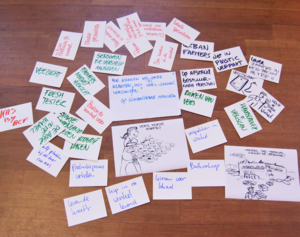Design Question

The design question provides a new lens to possible solutions and provides in itself a strategy for future change.
Goal
The design question “How might we...?” helps to give direction to the solution space that you are aiming for. Furthermore, the design question is a starting point for brainstorming ideas. Good design questions promise new insights, open up to new possibilities, and encourage breakthrough thinking.
Materials
Instructions
Design Question is all about asking the question “How might we...?”. “How” helps us to think in possibilities, it suggests that we do not have the answer yet. “Might” opens up to various solutions, instead of the ‘one and only’ solution. “We” emphasizes the power of collaboration, of bringing various stakeholders to the table to better understand what problems we need to find solutions to.
Instructions
1. Start with an insight, assumption, or insightful topic or theme. Reframe your insight, assumption, topic or theme to a question that starts with “How might we…?”. Preferably in teams.
2. Brainstorm on possible design questions. Craft a list of several design questions. Great design questions invite you to explore further and challenge you to discard your previous answers. They promise new insights, open up to new possibilities, and encourage breakthrough thinking (see Art of Questions exercise).
3. Test your question. The only way to find out if your question is a good question is to test it. A good question has a need to be answered. Ask your question aloud, do many ideas come to you? Are those the ideas that you are looking for, or do you need to shift the emphasis in your question?
4. Broaden or narrow the design question. Does your question allow for a variety of solutions? If they don’t, broaden them. Your design questions should generate a number of possible answers. Is your question too broad? Narrow it down. It should frame you to a great start for brainstorming ideas but should be inviting to explore wild ideas as well.
5. Wordsmithing. Analyze your sentence: find the active verbs, the subject. What changes do you need to make? What alternative verbs can you come up with? Is your subject actually the one you are finding a solution for?
6. Finalize. Use this format, if needed. How might we … (active verb). For … (target audience / subject). By .. (direction / change). So they can … (benefit).
Attachments
- Kopie_van_Design_Question_Ideation.png
Background
Sid Parnes – Creative Behavior Guidebook